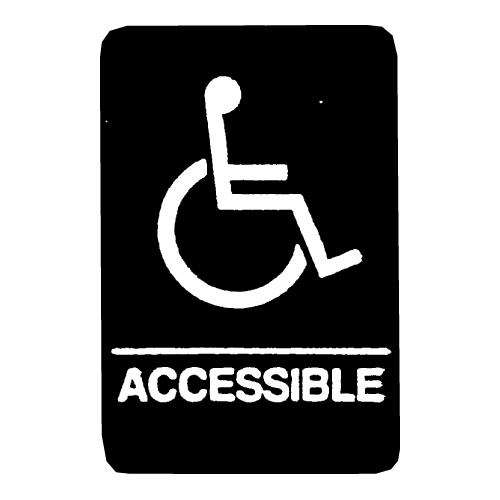Comprehending the Rules Behind ADA Signs
Comprehending the Rules Behind ADA Signs
Blog Article
How ADA Indicators Transform Rooms for Individuals With Disabilities
The improvement of rooms via ADA indications for individuals with specials needs is a profound testament to the power of ease of access. By adhering to ADA compliance, environments end up being secure and accessible, with signs that feature essential elements like high-contrast shades and Braille, therefore enhancing presence and comprehension. Beyond plain performance, these indicators add to community addition, supplying a feeling of empowerment and belonging. As we look towards future trends in accessible signs, one should think about just how developing technologies could further reinvent these rooms. What chances and obstacles lie in advance in ensuring these rooms remain comprehensive for all?

Relevance of ADA Conformity
Making sure ADA compliance is not just a lawful responsibility but also a social commitment to inclusivity and ease of access. By adhering to the guidelines established forth in the Americans with Disabilities Act (ADA), companies demonstrate their devotion to creating settings where people with impairments can navigate and involve without obstacles. ADA conformity is essential in getting rid of discrimination, fostering equality, and promoting self-reliance for people with disabilities.
Services and public organizations profit significantly from ADA conformity. By making certain centers are available to everyone, organizations can draw in a wider client base, including the 61 million Americans living with specials needs.
In addition, ADA conformity is a foundation of global design, which stresses producing areas that suit all people, no matter their abilities. By executing certified signage and attributes, organizations contribute to a more fair society, where all participants can get involved totally. Eventually, ADA conformity transcends lawful obligation, symbolizing a societal value that prioritizes empowerment and level playing field for everybody.
Enhancing Navigation and Safety
Navigating rooms with self-confidence and security is crucial for individuals with specials needs, and ADA-compliant signs plays a crucial function in achieving this objective. These indicators are made with specific functions to satisfy the diverse requirements of individuals with numerous impairments, consequently facilitating smoother and safer navigation throughout public and personal rooms. By providing clear, standardized information, ADA signs reduce complication and promote a greater feeling of independence for individuals who rely upon them.
The tactical positioning of ADA indicators ensures that important info is easily accessible to everybody, including those with aesthetic, acoustic, or cognitive problems. Responsive and Braille components on indicators help aesthetically impaired people separately locate leaves, restrooms, and various other crucial locations. In emergency situations, ADA signs add to efficient discharges by clearly noting fire escape and routes, therefore improving safety for all passengers.
Furthermore, ADA-compliant signs foster a comprehensive atmosphere by dealing with the distinct navigating difficulties encountered by people with disabilities. This not just help in their individual security but also urges engagement in social activities by advertising equivalent access to public solutions and centers. Eventually, efficient ADA signs changes spaces right into accessible, secure, and welcoming settings for everybody.
Features of Effective ADA Signs
To develop effective ADA signs, it is vital to integrate details attributes that attend to the diverse availability needs of people with impairments. One essential attribute is making use of high-contrast shades, which substantially enhance visibility for people with visual problems. The history and message ought to contrast dramatically to make sure the info is quickly discernible. Furthermore, the text needs to be in a sans-serif this page typeface, as these typefaces provide more clear readability at a range.
One more important attribute is dig this responsive components, such as raised personalities and Braille, promoting gain access to for visually impaired individuals. The elevated characters must be at least 1/32 inch over the surface, enabling very easy touch reading. Braille needs to be placed straight listed below matching message, guaranteeing uniformity and convenience of navigation.
The positioning of ADA indicators is also crucial for their performance. They must be installed at an elevation in between 48 to 60 inches from the ground to guarantee they are accessible for individuals in wheelchairs or those with mobility aids. Indications must be located near doorways, elevators, and bathrooms, guaranteeing that vital info is available specifically when needed. By integrating these attributes, ADA signs can substantially boost wayfinding and availability for all.
Influence On Neighborhood Inclusion
ADA indications considerably contribute to neighborhood inclusion by making certain that public spaces are accessible and easily accessible for people with impairments. These indications, created in conformity with the Americans with Disabilities Act (ADA), function tactile components, braille, and high-contrast shades, assisting not only those with visual disabilities yet a diverse series of specials needs - ADA Signs. As a result, they play a pivotal role in developing environments where people with impairments can get involved fully and individually in area life

In addition, ADA indicators assist organizations and institutions fulfill lawful obligations, thereby stopping potential discrimination lawsuits and improving their credibilities as comprehensive entities. Ultimately, ADA indications are vital tools in the continuous initiative to build even more fair and easily accessible communities for every person.
Future Trends in Accessible Signs
The combination of innovative technologies promises to change how individuals with disabilities engage with their environments. Electronic indications furnished with sensors and connection can interact with personal devices to provide customized details, such as text-to-speech for aesthetically damaged individuals or simplified graphics for those with cognitive handicaps.
Enhanced fact (AR) also holds considerable potential. AR applications can overlay digital info onto real-world environments, offering users with improved navigational help and contextual information (ADA Signs). This can be particularly helpful in intricate setups like airports or large public locations where typical signs might fail
An additional arising trend is the consolidation of Internet of Things (IoT) technology to create a network of interconnected signs. This enables real-time updates and boosted availability, adjusting to modifications in the environment or user demands. In addition, with the growing focus on inclusivity, future guidelines might press for a lot more innovative signage services, making certain global access and cultivating an extra inclusive society for all people.
Conclusion
ADA signs play a crucial function in transforming rooms for people with specials needs by making certain ease of access and advertising independence. Compliance with ADA standards enhances navigating and safety and security with making use of high-contrast colors, tactile components, and Braille. These functions promote community incorporation and equip people by producing barrier-free environments. The constant advancement of easily accessible signage guarantees further improvements in inclusivity, inevitably boosting the overall experiences of people with disabilities and strengthening their feeling of belonging in neighborhood life.
The change of spaces with ADA indications for individuals with disabilities is a profound testimony to the power of ease of access.To develop effective ADA indicators, it is important to integrate particular functions that deal with the diverse ease of access demands of people with disabilities.ADA indications substantially contribute to community addition by guaranteeing that public rooms are accessible and easily accessible for individuals with impairments.By assisting in the simplicity of movement and understanding within public rooms, ADA indications promote a sense of belonging and empowerment amongst individuals with handicaps.ADA indicators play a vital duty in changing rooms for people with impairments by ensuring ease of access and advertising freedom.
Report this page